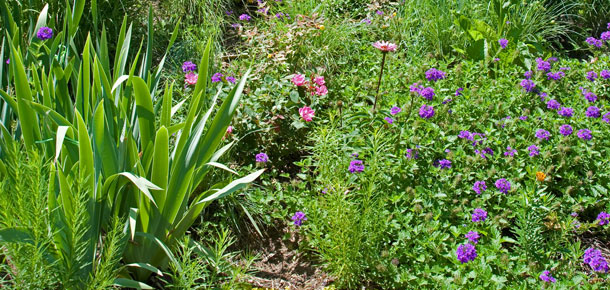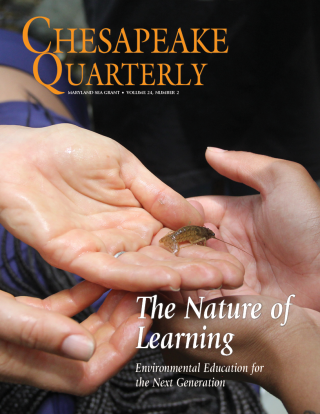Knauss legislative fellowships in Congress help build careers — and they're fun and educational. See our video and fact sheet for details.
The Maryland Sea Grant Bookstore will be closed for the winter holidays from Monday, December 15th to Friday, January 2nd and will not be taking orders during that time.
Rain Gardens

At Maryland Sea Grant Extension, we take an “every little bit helps” approach to cleaning up the Bay. In other words, even small actions can add up if enough people are involved.
Rain gardens can certainly fit the bill. Rain gardens, or bioretention areas, are similar to ordinary gardens — except they’re dug deeper and incorporate a mixture of soil, sand, and compost. Essentially, they act like a sponge in your front lawn. Rain gardens are placed between stormwater runoff sources (roofs, driveways, parking lots) and runoff destinations (storm drains, streets, and streams.)
These gardens soak up water during storms, lowering the risk of flooding around your home. Rain gardens also help to retain many of the pollutants carried in stormwater — like lawn fertilizers, sediment, and pet waste — keeping them out of your local streams.
Rain gardens can help to improve the water quality in your community. After years of development, many regions of Maryland are now crisscrossed by roads, parking lots, and turf grass lawns. Water can’t soak into any of these surfaces like it does in natural soil. These changes to the normal cycling of water throughout a watershed can lead to a number of unwanted impacts:
- Because storm water can’t soak into the soil, some developed areas are prone to flooding during big rains.
- As stormwater flows off pavement and into creeks, it carries pollutants, such as excess nutrients, into local waterways. That can degrade the quality of water in your community.
- Polluted streams also flow into the Bay. As a result, the water that rushes off of your roof can affect the health of the Chesapeake Bay.
Planting a Rain Garden
Homeowners and property owners can install a rain garden at a reasonable expense and in a reasonable amount of time.
An array of native flowers and grasses are planted in rain gardens, making them a beautiful addition to your property. Many organizations and government groups also provide funding and technical assistance for homeowners interested in rain gardens.
To learn more about rain gardens, contact the watershed restoration specialist in your area of Maryland.
.jpg) Download a free rain garden app for detailed information about how to install your own rain garden and plant it with native vegetation. The app, developed by the University of Connecticut for those in that state, now includes information for New Jersey, Delaware, and Maryland. Maryland Sea Grant Extension specialists contributed to expanding the app for Maryland.
Download a free rain garden app for detailed information about how to install your own rain garden and plant it with native vegetation. The app, developed by the University of Connecticut for those in that state, now includes information for New Jersey, Delaware, and Maryland. Maryland Sea Grant Extension specialists contributed to expanding the app for Maryland.
You can also watch these short videos, produced by Maryland Sea Grant Extension in partnership with Angie’s List, the consumer website. The videos will take you through the steps below to install your own rain garden.
- Introduction: An overview to this beginner’s guide to rain gardens
- Step 1, Selecting a Site: Where to install your rain garden so that it does the most good
- Step 2, Testing the Soil: What kind of soil you have will determine how easily water can pass from your rain garden into the ground below
- Step 3, Digging and Filling: Get dirty and find out how to construct your rain garden
- Step 4, Planting Native Plants: Using plants native to Maryland will make your rain garden appealing to the eye and will help your local ecosystem
- Rain Garden Time Lapse: A time-lapse video showing four workers installing a rain garden in three hours.
These videos were produced with funding from the Chesapeake Bay Trust. They were filmed and edited by Joe King.
Survey of Storm Water Practices
Few owners of single-family homes (only 2.5 percent) have installed rain gardens. But a rebate program for covering the installation cost could increase that.
Those are among the findings of a report and survey by University of Maryland Extension. The report discusses homeowners' awareness of, and obstacles to their adopting, four Best Management Practices for controlling storm water: rain gardens, rain barrels, low fertilizer lawn care, and conservation landscaping.
The report also offers information that could help local governments and outreach professionals target specific groups to increase adoption or awareness levels.





